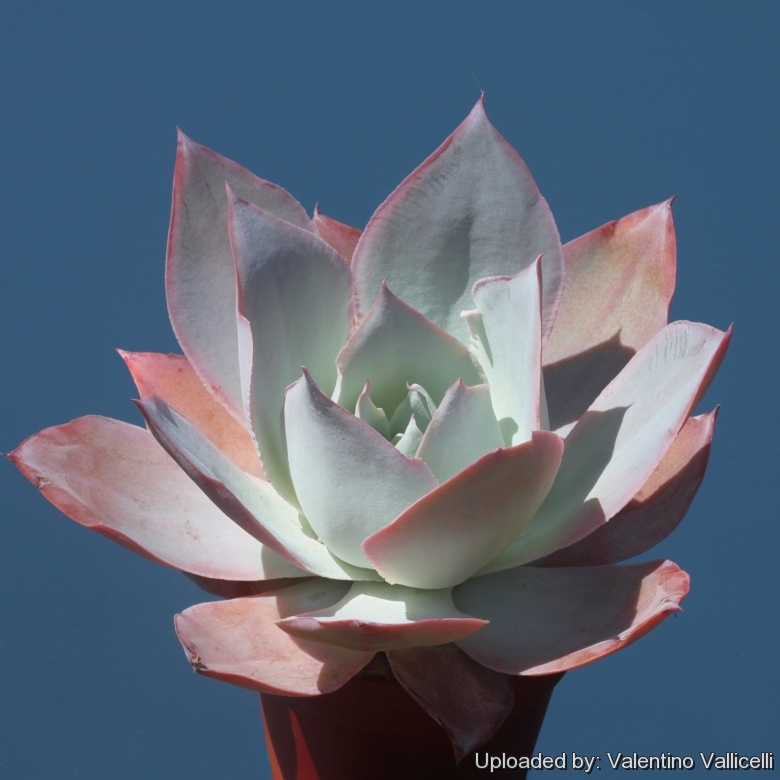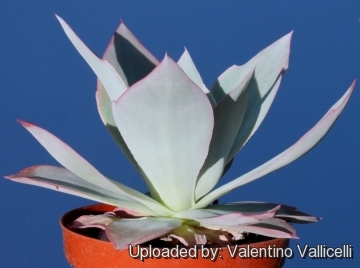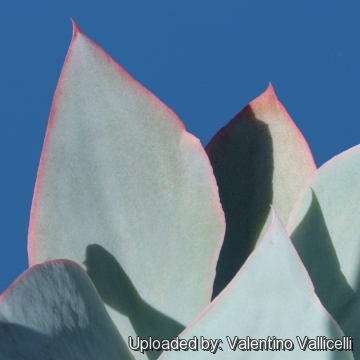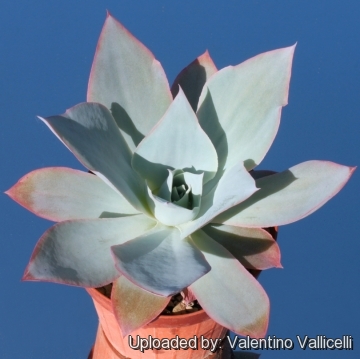
Echeveria subrigida Photo by: Valentino Vallicelli
It produces rosettes of smooth, tapered very pruinose (vs. bright green) leaves margined in red, grows to 60 cm in diameter and as high over time, the leaves have often rippled edges.
Origin and Habitat: Mexico: Mexico, Hidalgo, San Luis Potosi, Guanajuato, Queretaro.
Synonyms:
See all synonyms of Echeveria subrigida
back
Accepted name in llifle Database:Echeveria subrigida (B.L.Rob. & Seaton) Rose ex Britton & RoseBull. New York Bot. Gard. 3: 10. 1903Synonymy: 5
Cultivars
(1):
back
Description: Echeveria subrigidaSN|12349]]SN|12347]] is one of the most distinct of all Echeveria species with white-glaucous leaves like a Dudleya with a faint pink flush which, together with the meal that covers them, makes them look luminous. Of all the many beautiful Echeverias there are, none can surpass or even compare with the loveliness of Echeveria subrigidaSN|12347]]SN|12347]] and always causes gasps of admiration. The flowers are particularly beautiful because of the grace of the long stems. As flowering progresses the head slowly unfurls.
Similar species: Echeveria subrigida distinguishes from Echeveria palmeriSN|12347]]SN|12349]] on the basis of its very pruinose (vs. bright green) leaves, but otherwise they are very similar.
Habit: Stemless with leaves in dense solitary rosettes up to 30 cm in diameter.
Stem: Very short, stocky occasionally to 10 cm. thick.
Leaves: 15-25 cm long, 5-10 cm broad, very thin, obovate to oblanceolate, pointed, way, almost white-glaucous, tinged lavender, margin of young leaves scarlet , upturned and with finely rounded teeth.
Inflorescence: Flowering-stems 1 or 2 at a time, erect, pruinose, 60-90 cm tall with 6-15 branches, each with panicles of about 15 flowers. Bracts few 1-5 cm long. Sepals to 2,1 cm. Just equal, triangular to lanceolate. ascending, grey-purple. Corolla 2-2,5 cm red, bloomed white outside, yellow-red within. 5-sided, not very constricted at mouth.
Booming season: Summer.
Bibliography: Major referencens and further lectures
1) Eric Walther “Echeveria” California Academy of Sciences, 1972
2) Hermann Jacobsen “A handbook of succulent plants: descriptions, synonyms, and cultural details for succulents other than Cactaceae, Volume 1” Blandford Press, 1960
3) Alfred Byrd Graf “Exotica, series 4 international: pictorial cyclopedia of exotic plants from tropical and near-tropic regions” Roehrs Co. Publishers, 1985
4) John Pilbeam “The Genus Echeveria” British Cactus & Succulent Society, 2008
5) James Cullen, Sabina G. Knees, H. Suzanne Cubey “The European Garden Flora Flowering Plants:A Manual for the Identification of Plants Cultivated in Europe, Both Out-of-Doors and Under Glass” Cambridge University Press, 11/ago/2011
7) Diana Morgan “Succulents for Mediterranean Climate Gardens” Rosenberg Publishing Pty, Limited, 2004
 Echeveria subrigida Photo by: Valentino Vallicelli
Echeveria subrigida Photo by: Valentino Vallicelli Echeveria subrigida Photo by: Valentino Vallicelli
Echeveria subrigida Photo by: Valentino Vallicelli - It produces rosettes of smooth, tapered very pruinose (vs. bright green) leaves margined in red, grows to 60 cm in diameter and as high over time, the leaves have often rippled edges. Photo by: Valentino Vallicelli
- It produces rosettes of smooth, tapered very pruinose (vs. bright green) leaves margined in red, grows to 60 cm in diameter and as high over time, the leaves have often rippled edges. Photo by: Valentino VallicelliSend a photo of this plant.The gallery now contains thousands of pictures, however it is possible to do even more. We are, of course, seeking photos of species not yet shown in the gallery but not only that, we are also looking for better pictures than those already present.
Read More... Cultivation and Propagation: Echeveria subrigidaSN|12347]]SN|12347]] is a summer-growing and relatively easy plant thought not the easiest of the echeverias. It makes great potted specimens.
Soil: Use a very porous soil, which will allow quick drainage.
Repotting: If potted, repot them preferably in the spring, if their roots become cramped. Generally, they should be repotted every other year in order to provide fresh soil. However, this doesn't necessarily mean they'll need larger containers. Fill about a quarter of the pot with broken crocks, gravel, etc. to promote good drainage. After repotting, do not water for a week or more. Use pot with good drainage. Eventually, as the plant becomes mature grow it slowly, and adopt a new repotting period, using intervals of every 2 - 3 years. Additionally grow it under drier conditions or with stronger sunlight.
Fertilization: Slow release fertilisers with a low to moderate nitrogen content are adequate for the spring and summer growing seasons, and additional fertiliser applications would not required until spring.
Exposure: It can tolerate sun to shade but - generally speaking - the more light a plant gets the better it will display its colours and shape. However, when moving plants from lower light conditions into full sun, be wary of sun scorch, most easily avoided by ensuring plants are well-watered before moving them on a cloudy day.
Watering: They can tolerate extended dry periods and survive drought without the need for watering, but they will grow stronger if they receive adequate moisture during their growing season, amd never allowing the plant to remain waterlogged (root rot sensitive).
Ventilation: Good air movement is important for minimising pest and disease risks, and avoiding excessive humidity in cool winter conditions is important to successfully growing Echeveria in the nursery environment.
Hardiness: It can tolerate light frosts, but it is best overwintered at 5-10 °C.
With the cooler autumn temperatures tending to make their foliage colours become more intense than those of the active summer growing season.
Pest & disease: Aphids like this plant (and all flowering Echeveria).
Maintenance: Remove older dead leaves that build up at the base.
Propagation: Usually by seeds, but If the plant is repotted some of the bottom leaves can be removed, in order to attempt leaf propagation, it is also a common practice to collect the leaves on the flower stem. However this is not one of the easiest species to root, as many such cuttings will dry out without producing a plantlet, but with perseverance it is likely to get a few new plants.













